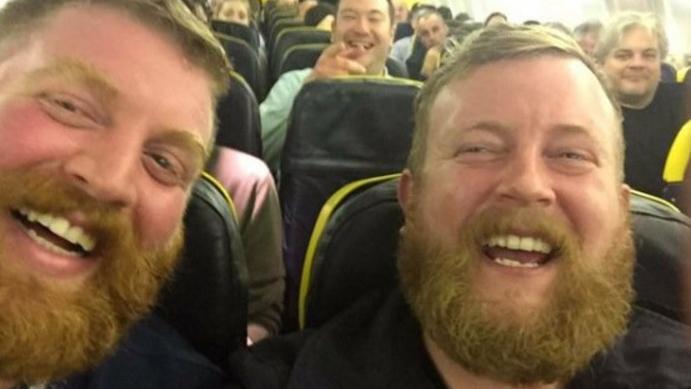Douglas (right) and his doppelganger, en route to Galway
Neil Thomas Douglas got the shock of his life last week when he boarded a plane, only to see himself. Already seated.
“At first it took me back a bit,” he says. “But then I just burst out laughing."
Douglas was on a flight to Galway, Ireland last Thursday, and was seated — completely by chance — next to a guy with the same red hair, same ginger beard, same body type.
And it didn't stop there.
"There's lots of ginger guys with big beards in Scotland, you know,” says Douglas. “But it was the facial features … and a dentist tweeted me saying it's the teeth, as well. Which is very bizarre.”
A photo of the two men on the plane went viral.
But it gets better. Douglas and his doppelganger from London share similar tastes as well:
"Well, what happened when we got off the flight, I went to the hotel where I was staying, and he was actually staying in the same hotel,” recounts Douglas. “So … I got in late, went for a shower and went out to sample Galway's nightlife. And the first bar I went into, he was there. So we had a pint and a laugh about it, you know."
Douglas went to Galway to photograph a wedding. His doppelganger was going there for a party.
Most people think of doppelgangers in only one sense: of people that look exactly like you, even though you’re not related. Well, you might be. It’s really just an accident of genetics.
But the original meaning was darker, and encapsulated a paranormal phenomenon known in any cultures around the world, where individuals run into apparitions of themselves. This vision or presence usually comes as a harbinger of bad luck or even death. Many cultures share this kind of 'first-comer' phenomenon, from Ancient Egypt through many Celtic cultures.
The concept has been used in literature to explore the duality of human nature, like in Edgar Allen Poe's story "William Wilson," or in Goethe, and in lots of Scottish stories. "Frankenstein" author Mary Shelley wrote privately about her husband having forebodings and seeing himself before his death. An image of her husband, Percy Bysshe Shelley, appeared to a friend at home around the time the poet drowned off the coast of Italy.
Some argue there may be an explanation for this unpleasant experience in the medical phenomenon known as heautoscopy. That’s when some people with epilepsy or schizophrenia believe they can see themselves.
Douglas was not too worried, and shared a quiet pint with his double.
The word doppelganger was first used in a published work in 1796 by the German writer, known as Jean Paul, and was explained in a footnote to mean the dark harbinger phenomenon. The English language had its own word for it, back then, which was "fetch." But doppelganger entered English in the mid-19th century, and over time morphed to assume the meaning of look-alike.
Doppelgangers have been long sought after by dictators, to act as decoys for assassins after people like Adolf Hitler and Stalin.
Also in World War II, the British army hired an actor who looked like their famous general, Bernard Montgomery, to act as a decoy. The actor M.E. Clifton James was recruited by none other than David Niven — then a colonel in the army's Cinematic section. He was trained to learn the general’s mannerisms and sent on a well-publicized tour of the Mediterranean, in an effort to confuse the Germans about Allied invasion plans before D-Day. A book and movie followed in the 1950s.
And what history of doppelgangers would be complete without mentioning the "History of the World Part I," where Mel Brooks appears as the King of France and his body-double, Jacques the Piss Boy.
It's good to be the king. Or someone who looks just him.
Our coverage reaches millions each week, but only a small fraction of listeners contribute to sustain our program. We still need 224 more people to donate $100 or $10/monthly to unlock our $67,000 match. Will you help us get there today?
